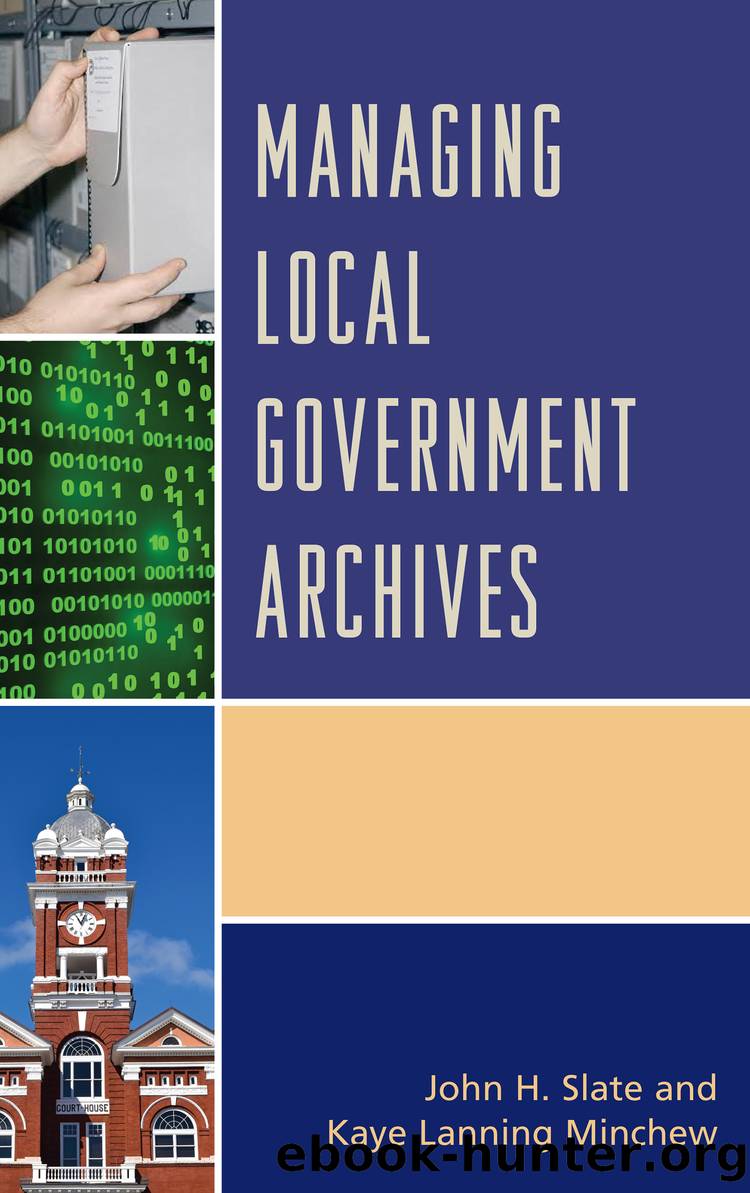Managing Local Government Archives by Slate John H.;Minchew Kaye Lanning; & Kaye Lannng Minchew

Author:Slate, John H.;Minchew, Kaye Lanning; & Kaye Lannng Minchew [Slate, John H. & Minchew, Kaye Lannng]
Language: eng
Format: epub
Publisher: Rowman & Littlefield Publishers
Published: 2016-08-15T00:00:00+00:00
Security
Because local government archival records contain legal, historical, administrative, intrinsic, and other kinds of value, they must be kept safe and secure. Archival materials are tempting targets for thieves because they may have value on the black market and even on online auction and shopping sites such as e-Bay. Records from the seventeenth, eighteenth, and nineteenth centuries as well as items with the signatures of major political figures may be objects of desire for private collectors. Thieves can come in the form of both researchers and sadly even inside staff, so vigilance and precaution are paramount. Researchers have been known to cultivate relationships with staff members to the point where they are trusted more than they should be. A sheriffâs deputy from a neighboring county, for example, managed to steal many documents from a county archives after the small staff allowed him to be alone with records.
Fortunately, government facilities are usually already outfitted with some security features, such as controlled access points into the building, patrolling security staff and monitored hallways, and camera systems to detect unauthorized entry or activity. Be sure that research areas, staff-only areas, and storage areas are distinct and separated by locked doors (or doors that can be locked) to make clear where researchers can and cannot travel. The use of lockers for personal belongings should be an important feature of your research area and sends a strong message that users are under supervision at all times.
Only designated facilities staff and archives staff should have access to storage areas; limit the number of sets of keys or electronic keypad passwords distributed to reduce the chances of unauthorized entry. Doors to storage areas should remain locked when not in use, and clerical staff and volunteers should use a set of keys that are kept in a central location for use only during opening hours. Donât allow keys to leave the premises if at all possible. Some archives include a secondary gated anteroom to further discourage theft. When closing for the day, always test doors and locked gating to ensure locks are engaged. If your facility uses a keypad alarm system, be sure you know how to arm and disarm it quickly, and have security force contacts available should there be an accidental alarm failure.
Download
This site does not store any files on its server. We only index and link to content provided by other sites. Please contact the content providers to delete copyright contents if any and email us, we'll remove relevant links or contents immediately.
The Secret History by Donna Tartt(18232)
The Social Justice Warrior Handbook by Lisa De Pasquale(11963)
Thirteen Reasons Why by Jay Asher(8472)
This Is How You Lose Her by Junot Diaz(6463)
Weapons of Math Destruction by Cathy O'Neil(5854)
Zero to One by Peter Thiel(5508)
Beartown by Fredrik Backman(5372)
The Myth of the Strong Leader by Archie Brown(5250)
The Fire Next Time by James Baldwin(5033)
How Democracies Die by Steven Levitsky & Daniel Ziblatt(4972)
Promise Me, Dad by Joe Biden(4916)
Stone's Rules by Roger Stone(4875)
100 Deadly Skills by Clint Emerson(4700)
A Higher Loyalty: Truth, Lies, and Leadership by James Comey(4567)
Rise and Kill First by Ronen Bergman(4554)
Secrecy World by Jake Bernstein(4407)
The David Icke Guide to the Global Conspiracy (and how to end it) by David Icke(4397)
The Farm by Tom Rob Smith(4332)
The Doomsday Machine by Daniel Ellsberg(4253)
